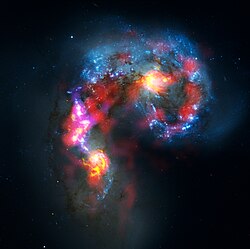ESO - Four ALMA antennas on the Chajnantor plain (by)
Attribution:
Das Bild ist mit 'Attribution Required' markiert, aber es wurden keine Informationen über die Attribution bereitgestellt. Vermutlich wurde bei Verwendung des MediaWiki-Templates für die CC-BY Lizenzen der Parameter für die Attribution weggelassen. Autoren und Urheber finden für die korrekte Verwendung der Templates hier ein Beispiel.
Größe:
1280 x 720 Pixel (55335118 Bytes)
Beschreibung:
Time-lapse of a whole night at the ALMA Array Operations Site (AOS), located at 5000 metres altitude on the Chajnantor plateau, in the II Region of Chile. As the Moon sets at the beginning of the night, three of the first ALMA antennas start tests as part of the ongoing Commissioning and Science Verification process. Because they are pointing at the same target in the sky at any moment, their movements are perfectly synchronised. As the sky appears to rotate clockwise around the south celestial pole (roughly on the upper left edge of the image), the Milky Way goes down slowly, until it is lying almost horizontal before sunrise. The centre of our galaxy becomes visible during the second half of the night as a yellowish bulge crossed by dark lanes in the centre of the image, just above the antennas. The flashes on the ground are the car lights of the guards patrolling at the AOS. ALMA, the Atacama Large Millimeter/submillimeter Array is the largest astronomical project in existence and is a truly global partnership between the scientific communities of East Asia, Europe and North America with Chile. ESO is the European partner in ALMA.
Kommentar zur Lizenz:
|
|
This media was created by the European Southern Observatory (ESO). Their website states: "Unless specifically noted, the images, videos, and music distributed on the public ESO website, along with the texts of press releases, announcements, pictures of the week, blog posts and captions, are licensed under a Creative Commons Attribution 4.0 International License, and may on a non-exclusive basis be reproduced without fee provided the credit is clear and visible."To the uploader: You must provide a link (URL) to the original file and the authorship information if available. |
- Dieses Werk darf von dir
- verbreitet werden – vervielfältigt, verbreitet und öffentlich zugänglich gemacht werden
- neu zusammengestellt werden – abgewandelt und bearbeitet werden
- Zu den folgenden Bedingungen:
- Namensnennung – Du musst angemessene Urheber- und Rechteangaben machen, einen Link zur Lizenz beifügen und angeben, ob Änderungen vorgenommen wurden. Diese Angaben dürfen in jeder angemessenen Art und Weise gemacht werden, allerdings nicht so, dass der Eindruck entsteht, der Lizenzgeber unterstütze gerade dich oder deine Nutzung besonders.
https://creativecommons.org/licenses/by/4.0CC BY 4.0 Creative Commons Attribution 4.0 truetrue |
Weitere Informationen zur Lizenz des Bildes finden Sie hier. Letzte Aktualisierung: Sat, 11 Mar 2023 20:15:18 GMT
Relevante Bilder
Relevante Artikel
Atacama Large Millimeter/submillimeter Array
Das Atacama Large Millimeter/submillimeter Array (ALMA) ist ein internationales Radioteleskop-Observatorium in den nordchilenischen Anden. Seine Antennenanlage besteht aus 66 transportablen, ausrichtbaren Parabolantennen, mit meist 12 m Durchmesser, die über Entfernungen von bis zu 16 km verteilt werden können und zu einem Interferometer-Radioteleskop zusammengeschaltet werden. Die Antennen befinden sich bei San Pedro de Atacama, in der Chajnantor-Hochebene, in mehr als 5000 m ü. M., wo die dünne und extrem trockene Erdatmosphäre für Radiowellen besonders durchlässig ist. Beobachtungsobjekt ist die kalte interstellare Materie, zur Erforschung der Stern- und Planetenentstehung. Das Radioteleskop wurde in einer internationalen Kooperation gebaut und wird von ESO, AUI/NRAO und NAOJ gemeinsam betrieben.
.. weiterlesen








